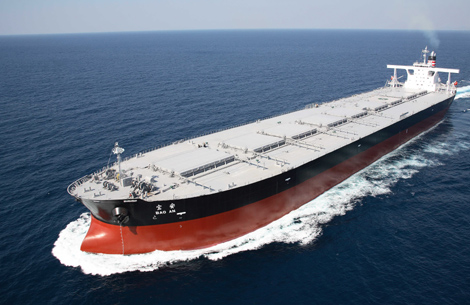-
News >Bizchina
Shipping bottoming on China steel rebound
2010-07-27 10:38
An undated handout photograph shows Nippon Yusen KK's dry-bulk ship. Expectations for higher shipping costs suggest the 78 percent plunge in capesizes since June 2 doesn't point to a new global economic slump. [Nippon Yusen KK / Bloomberg News]
Improving Chinese demand likely to ease transport industry glut
LONDON - The smallest profits in the commodity shipping market in 18 months may be ending as a rebound in steel and iron-ore prices signal improving Chinese demand that will ease the transport glut.
Chinese steel prices rose 4.7 percent last week, the most in 11 months. Derivatives for fourth-quarter iron-ore prices jumped 23 percent between July 9 and 21, Deutsche Bank AG said. Costs for leasing capesize ships used to carry iron ore will average $30,375 a day in the fourth quarter, from $12,755 now, according to the median in a Bloomberg survey of 18 analysts.
Expectations for higher shipping costs suggest the 78 percent plunge in capesizes since June 2 doesn't point to a new global economic slump. While last month's Chinese steel output was the smallest since February, the nation still accounted for 45 percent of global supply. Three consecutive months of lower iron-ore imports may mean mills are running down inventories."This is hand-to-mouth stuff," said Stuart Rae, London-based co-managing director of M2M Management Ltd, a $450 million hedge fund group that operates ships and trades freight derivatives.
"By the fourth quarter, stockpiles will have been depleted to a point that, strategically, they will want to try and build them up," said Rae, who correctly predicted a decline in shipping rates at the end of 2008.
Capesizes, three times the length of a football field, were last this cheap in the first quarter of 2009, when the US contracted 6.4 percent and Chinese growth fell to 6.2 percent, the slowest since 1999. Now, China will expand 8.95 percent in the fourth quarter and the US will gain 2.8 percent, according to as many as 54 economists surveyed by Bloomberg. The world is "very far from any kind of double dip", International Monetary Fund Managing Director Dominique Strauss-Kahn said on July 13.
Forward freight agreements traded by brokers and used to bet on or hedge against dry-bulk rates are already anticipating a rebound, pricing in a fourth-quarter average of $26,625, according to data from the Baltic Exchange.
That's $3,750 less than the median in the Bloomberg survey. Capesize rates more than quadrupled last year as the US economy accelerated from a first-quarter contraction to 5.6 percent growth in the final three months of the year, the fastest pace since 2003.
Chinese prices for rebar, steel used to reinforce concrete in roads and buildings, advanced for five consecutive days through July 23, reaching 3,995 yuan ($589) a metric ton, data from Beijing Antaike Information Development Co show. Prices had fallen 17 percent since April.
The cost of 62 percent iron-content ore delivered to Tianjin port in China gained 8 percent to $127 a ton since July 14, rebounding from a 37 percent drop that began in April, according to data provider The Steel Index. Fourth-quarter iron-ore swaps, traded off exchanges, rose to $123 a ton on July 21 from $100 on July 9, according to Deutsche Bank.
China accounts for 64 percent of the seaborne iron-ore market, the single biggest source of demand for dry-bulk shipping, according to Clarkson Plc, the biggest shipbroker. Iron ore represents about 75 percent of capesize cargoes, according to Georgi Slavov, head of freight and basic resources research at ICAP Shipping International Ltd in London.
"Chinese iron-ore demand is very, very important for the capesize market, it's the most important thing driving rates higher or lower," said Rahul Sharan, an analyst at Drewry Maritime Services in Gurgaon, near New Delhi.
Global shipments of iron ore will advance 6 percent to a record 961 million tons this year, Clarkson estimates. The brokerage also predicts a 9 percent gain in coal cargoes to an all-time high of 874 million tons. The commodity is the second- biggest source of demand for capesizes.
